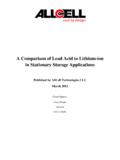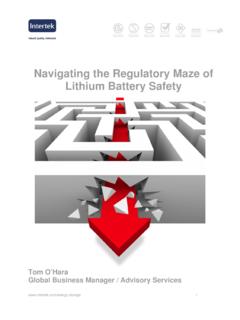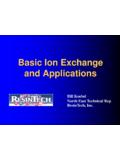Transcription of A Comparison of Lead Acid to Lithium-ion in …
1 A Comparison of Lead Acid to Lithium-ion in Stationary Storage applications Published by AllCell Technologies LLC. March 2012. Contributors: Greg Albright Jake Edie Said Al-Hallaj Lead Acid versus Lithium-ion White Paper Table of Contents 1. Introduction 2. Basics of Batteries Basics of Lead Acid Basics of Lithium-ion 3. Comparing Lithium-ion to Lead Acid Cycle Life Comparison Rate Performance Cold Weather Performance Environmental Impact Safety Voltage Comparison 4. Case Study 5. Conclusions List of Figures Figure 1: Battery Design Considerations Figure 2: Rechargeable Battery Types Figure 3: Lead Acid Charge States Figure 4: Lithium-ion reaction Figure 5: Cycle life, moderate climate Figure 6: Cycle life, extreme climate Figure 7: Capacity vs. Discharge Rate Figure 8: Capacity Available versus Temperature Figure 9: Lithium-ion safety mechanisms Figure 10: Voltage Comparison Figure 11: Annual Global Temperature List of Tables Table 1: Lithium-ion subcategory Comparison Table 2: Battery Technology Comparison Table 3: Generic System Specifications Table 4: Lifetime cost Comparison of VRLA to Li-ion Disclaimer: AllCell is a Lithium-ion battery pack assembler with a proprietary method for battery thermal management.
2 Information in this paper reflects AllCell's experience in the market across a variety of energy storage applications . 2. Lead Acid versus Lithium-ion White Paper 1. Introduction A wide variety of energy storage options are available today for the stationary power market; capacitors, compressed air, pumped hydro, flywheels and rechargeable batteries are all vying for a stake in the emerging role of energy storage. Each technology has its own merits based on a variety of application specific factors. This paper will focus on the Comparison of two battery chemistries: lead acid and Lithium-ion (Li-ion). The general conclusion of the Comparison is that while the most cost effective solution is dependent upon a number of factors, there is a large market segment where Lithium-ion has a lower cost of ownership when compared to lead acid. The figure below shows eleven variables that are included in the decision of what battery type to select for a given system.
3 Initial cost Safety Lifetime Reliability Engineering cost Environmental impact Maintenance cost Shipping cost Installation cost BOP cost Disposal cost Figure 1: Battery Design Considerations 3. Lead Acid versus Lithium-ion White Paper Within the scope of off-grid renewable systems, lead acid and nickel based batteries currently dominate the industry. Nickel batteries (NiCd, NiMH) are being phased out due to a combination of cost and environmental factors. Lead acid has been around for over 100 years and will be a market force for the foreseeable future due to its low cost and established manufacturing base. Lithium-ion is a well established technology for portable electronics but is still finding its role in larger scale applications ; it is emerging as a contender in certain stationary applications where volume, weight, temperature sensitivity or low maintenance is more important than initial cost.
4 The following chart illustrates how lead acid and Lithium-ion fit into the rechargeable battery world. Rechargeable batteries Lead Acid NiCd Lithium-ion Flooded Valve regulated/ Iron phosphate Nickel, Cobalt, Sealed Manganese AGM Gel Figure 2: Rechargeable Battery Types 2. Basics of Batteries Basics of Lead Acid Lead acid batteries have been around for more than a century. In the fully charged state, a 2V electric potential exists between the cathode and the anode. During discharge, electrons are passed externally through the load while internal chemical reactions at the interface of the electrolyte and the electrodes work to balance the charge equilibrium. Figure 3 illustrates the chemical states of a fully charged and discharged lead acid battery. Fully Charged Fully Discharged Anode Electrolyte Cathode Anode Electrolyte Cathode Pb H2SO4 PbO2 PbSO4 H2SO4 PbSO4. Figure 3: Lead Acid Charge States 4.
5 Lead Acid versus Lithium-ion White Paper Lead acid batteries can be divided into two distinct categories: flooded and sealed/valve regulated (SLA or VRLA). The two types are identical in their internal chemistry (shown in Figure 3). The most significant differences between the two types are the system level design considerations. Flooded lead acid batteries require three things that VRLA don't: 1. Upright orientation to prevent electrolyte leakage 2. Ventilated environment to diffuse gases created during cycling 3. Routine maintenance of electrolyte Due to these differences, the lower cost of flooded lead acid must be balanced against the added complexity and secondary costs. VRLA batteries are divided into two categories: Gel and Absorbed Glass Mat (AGM). The different names reflect different methods of containing the electrolyte. In Gel batteries, a thickening agent is added to turn the electrolyte from liquid to gel.
6 In AGM cells, a glass matrix is used to contain the liquid electrolyte. Deep cycle and shallow cycle lead acid batteries can be found in both the VRLA and flooded classes. Shallow cycle VRLA batteries are commonly used for automotive start, light, ignition ( SLI ) batteries that must deliver high power pulses for short durations. The stationary power market uses deep cycle since the batteries will often discharge at a low rate over the course of multiple hours. Basics of Lithium-ion The concept of a Lithium-ion battery was initially conceived in the 1970's and began to see widespread adoption by the 1990's. The basic mechanism is that a charged lithium ion is shuttled back and forth between the cathode and the anode during charge and discharge. Figure 4shows a diagram of a LiCoO2 variation of the Lithium-ion family. Figure 4: Lithium-ion reactioni Chemistry differences in the cathode, anode, and electrolyte influence cell performance, as does packaging geometry.
7 The cathode chemistry is the factor most commonly altered from cell manufacturer to cell manufacturer with terms like LFP, NCM, NCA, Cobalt, and Manganese reflecting the cathode chemistry class. Over 90% of Lithium-ion anodes are comprised of graphite;. silicon and titanium based materials are occasionally used to get better life and power performance in exchange for significantly higher cost. 5. Lead Acid versus Lithium-ion White Paper The electrolyte exists in liquid form, but for lithium polymer cells, the electrolyte is absorbed in a polymer membrane. This allows for cell manufacturers to use a pouch enclosure on the cell rather than the metal casing used when liquid electrolyte is present in cylindrical and prismatic shaped cells. Each of these variations influences the performance of a Lithium-ion cell. In spite of the various chemical variations, Lithium-ion batteries can generally be separated into two groups: lithium iron phosphate (LFP, LiFePO4) and metal oxides (NCM, NCA, Cobalt, Manganese).
8 Table 1outlines the differences between the two chemistry classes on a cell level. The values in the table reflect average values as there is variation in each class. Table 1: Lithium-ion subcategory Comparison LFP LiNCM. Voltage V nominal ( V nominal ( V/cell) V/cell). Energy Density 300 Wh/L 735 Wh/L. Specific Energy 128 Wh/kg 256 Wh/kg Power 1000 W/kg 512 W/kg Cycle Life 2,000 @ 100% DoD 750 @ 100% DoD. 3,000 @ 80% DoD 1,900 @ 80% DoD. Calendar Life 6 years 8 years Max recommended 40 C 55 C. temperature Safety High Moderate Commercial A123, Valence, BAK, Sanyo, Panasonic, Suppliers BYD, K2, Lishen, many Samsung, DowKokam, Chinese vendors Sony, LG Chem, Moli All Lithium-ion cells are deep cycle meaning that they have the ability to be fully charged and discharged. The life of the battery will significantly increase if the depth of each discharge is limited to 80% of the rated capacity.
9 6. Lead Acid versus Lithium-ion White Paper 3. Comparing Lithium-ion to lead acid Table 2 provides a brief Comparison of lead acid to Lithium-ion (LiNCM) on a pack level. It should be noted that both chemistries have a wide range of parameter values, so this table is only a simplified representation of a very complex Comparison . Table 2: Battery Technology Comparison Flooded lead acid VRLA lead acid Lithium-ion (LiNCM). Energy Density (Wh/L) 80 100 250. Specific Energy (Wh/kg) 30 40 150. Regular Maintenance Yes No No Initial Cost ($/kWh) 65 120 6001. Cycle Life 1,200 @ 50% 1,000 @ 50% DoD 1,900 @ 80% DoD. Typical state of charge 50% 50% 80%. window Temperature sensitivity Degrades significantly Degrades significantly Degrades significantly above 25 C above 25 C above 45 C. Efficiency 100% @20-hr rate 100% @20-hr rate 100% @20-hr rate 80% @4-hr rate 80% @4-hr rate 99% @4-hr rate 60% @1-hr rate 60% @1-hr rate 92% @1-hr rate Voltage increments 2V 2V V.
10 An interesting point in this table is that the different chemistries have different typical state of charge windows. The implication of this is that a lead acid system must have a larger nameplate energy capacity than the Lithium-ion system to have the same amount of available energy. Given the significant differences in technical and economic characteristics of the battery types, it stands to reason that the best solution for which battery type to use is application specific. Following is a more in-depth look at some of the topics addressed in Table 2. 1. There is a wide price range for Lithium-ion . $600/kWh represents estimated price at moderate production volumes. A similar concept applies to lead acid. There are various quality levels of lead acid, so some lead acid may have better cycle life, but will have a higher cost. 7. Lead Acid versus Lithium-ion White Paper Cycle Life Comparison Lithium-ion has significantly higher cycle life than lead acid in deep discharge applications .






